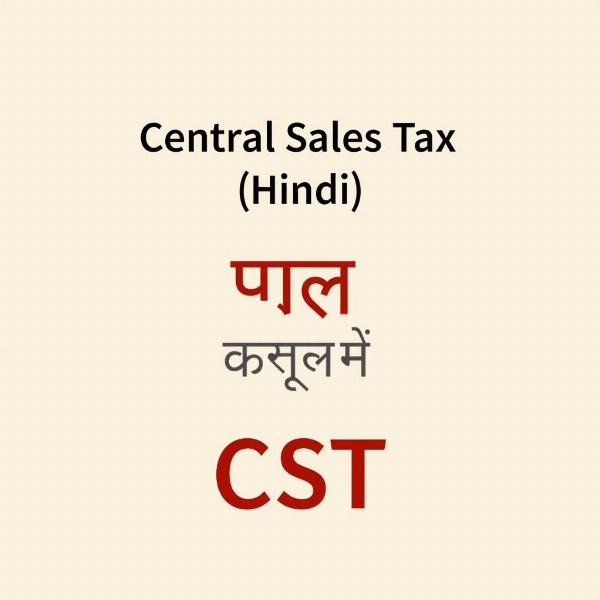CST, often encountered in official Indian documents, stands for Central Sales Tax. Understanding its meaning and implications is crucial for businesses operating across state lines. This guide explores the meaning of CST in Hindi, its relevance in the Indian taxation system, and its impact on businesses.
What does CST Stand For in Hindi?
CST in Hindi is known as केंद्रीय विक्रय कर (Kendriya Vikray Kar). “Kendriya” translates to Central, “Vikray” means Sales, and “Kar” signifies Tax. Therefore, the full form of CST in Hindi accurately reflects its English equivalent: Central Sales Tax.  CST Meaning in Hindi: Central Sales Tax
CST Meaning in Hindi: Central Sales Tax
What is the purpose of searching for “CST meaning in Hindi”? Users likely seek a clear and concise Hindi explanation of CST to understand its application in a business or legal context. They might also be looking for official Hindi documentation related to CST.
Understanding the Implications of CST
CST was a tax levied on interstate sales of goods in India. It played a significant role in regulating inter-state trade and generating revenue for state governments. Understanding its complexities was crucial for businesses engaged in interstate commerce.
Why was CST Important?
Before the implementation of the Goods and Services Tax (GST), CST was a vital component of the Indian taxation system. It ensured that goods moving between states were taxed appropriately. This prevented tax evasion and ensured a level playing field for businesses across different states.
The Transition from CST to GST
With the introduction of GST in 2017, CST was effectively subsumed. GST, a comprehensive indirect tax, aimed to simplify the taxation system and create a unified national market. While CST is no longer applicable, understanding its historical significance remains important for interpreting older documents and legal cases.
Key Differences Between CST and GST
Understanding the distinctions between CST and GST helps clarify the shift in the Indian taxation landscape.
- Scope: CST applied only to interstate sales of goods, while GST covers both intrastate and interstate supply of goods and services.
- Tax Structure: CST was a single-point tax levied at the origin state, whereas GST is a multi-stage tax collected at every stage of the supply chain.
- Administration: CST was administered by the respective state governments, while GST involves both central and state governments.
What were the challenges faced by businesses during the transition from CST to GST? Many businesses faced initial challenges adapting to the new GST system, including understanding the complex regulations, updating accounting software, and managing input tax credits.
Practical Examples of CST Application (Pre-GST Era)
Let’s consider a scenario before GST implementation:
A company in Maharashtra sells goods to a buyer in Gujarat. The transaction would be subject to CST, which would be collected by the Maharashtra government. This ensured that the interstate sale was taxed appropriately.
Expert Insights
Dr. Arvind Sharma, a renowned economist specializing in Indian taxation, states, “CST played a critical role in the Indian economy for several decades. While it has been superseded by GST, understanding its historical significance is crucial for analyzing past economic trends.”
Ms. Priya Desai, a legal consultant specializing in tax law, adds, “The transition from CST to GST represented a major shift in the Indian taxation system. It simplified many aspects of interstate trade but also presented new challenges for businesses.”
Conclusion
Understanding the meaning of CST (केंद्रीय विक्रय कर – Kendriya Vikray Kar) in Hindi and its historical significance is essential for comprehending the evolution of the Indian taxation system. While GST has replaced CST, its impact on interstate trade and its role in shaping the current tax landscape remain significant.
FAQ
- What is the full form of CST in Hindi? Kendriya Vikray Kar (केंद्रीय विक्रय कर).
- Is CST still applicable in India? No, CST was replaced by GST in 2017.
- What was the purpose of CST? To tax interstate sales of goods.
- Who collected CST? The state government from where the goods originated.
- How is CST different from GST? CST applied only to interstate sales of goods, while GST covers both intrastate and interstate supply of goods and services. CST was a single-point tax, while GST is a multi-stage tax.
- Why is it important to understand CST even after GST implementation? To understand older documents and legal cases related to interstate trade before 2017.
- Where can I find more information on CST? You can access archived government documents and legal resources related to CST.
Meaning-Hindi.in is your premier resource for professional Hindi translation services. We specialize in a wide array of translation needs, from business and legal documents to technical manuals and website localization. Whether you need accurate translations of financial reports, legal contracts, or educational materials, our team of expert linguists ensures precision and cultural sensitivity. We also offer expedited translation services for urgent projects. Contact us today for a free quote and experience the Meaning-Hindi.in difference! Email: [email protected], Phone: +91 11-4502-7584. Let Meaning-Hindi.in bridge the language gap for you.